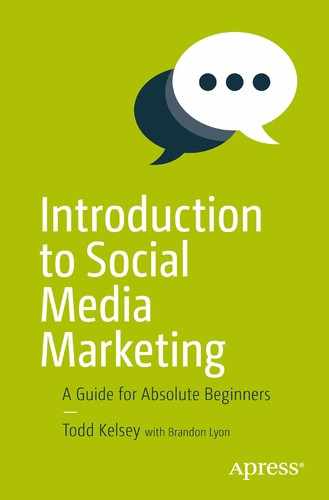The goal of this chapter is to introduce the concept of Facebook pages and walk through the process of creating one. The chapter starts off with a discussion of what a Facebook page is, as well as the pros and cons of using Facebook, and then there’s a tour of creating one. If you have not created a Facebook page before, I recommend giving it a shot, even if you don’t have an “official” project yet. As with many free tools these days, you can come back and delete it.
What Is a Facebook Page?
A Facebook page is a central “hub” for a business or non-profit organization to establish a social media presence on Facebook. It’s basically like having a web page or web site of your own, but “within” Facebook, and following its format. As a Facebook page owner, you can make posts of various kinds, including text, pictures, video, etc., and if users click the Like button on the page, then in theory, they will receive posts in their newsfeed when they log on to Facebook. Most social media marketers consider a presence on Facebook a must-have, but it’s worth knowing the limits and costs, as we’ll discuss.
Common Facebook pages includes ones about authors, movies, and entertainment.
For example, if you go on Facebook and type “matrix” in the search box, you can select “The Matrix” Facebook page. At this time, it has about 7 million people who’ve liked it.
Facebook pages also have “web addresses ,” which can be used in promotional materials to advertise or link to the page. For example, the direct link to “The Matrix” Facebook page is https://www.facebook.com/TheMatrixMovie .
Note
When you create a Facebook page for the first time, it may be a longer link, such as facebook.com/pages/name of your page/11887376363873. But there is a process to choose a shorter name for the Facebook page so that the direct link is easier to remember, like the one in this section for “The Matrix”.
When you access a Facebook page, depending on how things have been designed, you’ll generally see a prominent image at the top, a box with the Profile icon, and an area for posts below it.
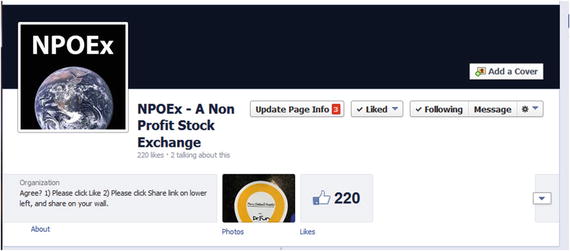
Notice the “Add a Cover” image. That’s one of the options for customizing your Facebook page , which—nudge , nudge—is an opportunity to work with digital images, as described in the last chapter. When you start making profile icons or cover images, it’s common to start with a picture and then resize it/crop it to a particular size.
Here is an example of a Facebook page that I liked. Because I liked it, a post showed up in my newsfeed.

In addition to entertainment and business, in the last few years, Facebook pages have also been increasingly been built around causes, and have had a direct impact on world events, both through official pages of movements, as well as independent pages.
For example, during the Arab Spring, I created a Facebook page with some music and poetry to encourage people who were protesting to bring about democracy in their countries in the Middle East. Check out www.facebook.com/freedomsongs .

You might be interested to review/discuss the nature of how the revolution in the Middle East was sparked. It wasn’t “caused” by social media, but it just so happens that a Facebook page was a central method of communication. See http://www.nytimes.com/2012/02/19/books/review/how-an-egyptian-revolution-began-on-facebook.html .
This was the page that basically started it: https://www.facebook.com/elshaheeed.co.uk .
You might also be interested in looking at a video I made, which tours the “Freedom Songs” Facebook page I made in support of the revolution, with a discussion of how Facebook advertising was used. It also includes some of the “behind the scenes” information on the Facebook page, including statistics that were gathered about people who visited and liked the page from various countries.
The title is “How to Start a Revolution (or Help One)” and a direct link is: http://tinyurl.com/fb-arabspring .
Facebook Pages: To Do or Not to Do ?
In my opinion, one of the most important points to keep in mind about Facebook pages, whether you are creating one for a business or non-profit organization, are the limitations. Facebook pages are often considered a central piece of social media strategy, and the general mindset is that they are a must-have. However, some technical changes at Facebook have changed the effectiveness of pages as a promotional tool, which is worth looking at.
Principle: What Is Facebook’s Business Model?
One thing that helped me in a book I read about Google (Winning AdWords by Danny Sullivan) was a challenge that Sullivan made about understanding Google’s business model. I think a similar principle can help social media marketers look at Facebook with a critical eye.
In Google’s case, the discussion was about techniques for getting a page listed on Google’s search engine for free , which is also known as SEO, or Search Engine Optimization . Google allows just about any web site to be listed for free, but it also offers the opportunity for paid advertisement. (The paid advertisement is known as Search Engine Marketing , or SEM).
In terms of business models, Google doesn’t technically make money from offering free placement on its search engine. When people submit links, and when Google crawls the Internet to discover sites automatically, it adds value to Google. However, the way Google makes most of its money is through ads. Tens of billions of dollars in ad revenue.
So the challenge is that, even if you put effort into the “free” techniques, it stands to reason that Google’s business model is about paid advertising, and that putting resources and effort into the paid techniques is more sustainable and reliable long term. Basically, Google doesn’t “promise” anything, even though an entire industry has grown around SEO. Even though the free Google placement, SEO, is a good thing to do, you can’t necessarily rely on it.
Once in a while Google will change the way web sites appear, which can have a pretty big impact on businesses that have made assumptions about their “free” SEO campaigns. In short, understanding where a business makes money can help you plan long-term and think critically about marketing in its “channel”.
In terms of social media, historically what happened is that Facebook grew, and then started thinking more about how to make money, which ultimately had a direct impact on Facebook pages.
The implicit assumption used to be that when you got people to like your Facebook page, the posts you made would appear in their newsfeeds. Kind of like a subscription. Social media was touted as a method where you could more or less get free advertising —self-promoting on “social media”—and then build a presence by putting content out there.
But then Facebook started charging for “boosting” posts .
I think the basic principle applies to Facebook too. Just keep in mind the question—how does Facebook make money? The answer is through advertising. So it’s likely that while you might get something for nothing, in the end it might not be sustainable, and it’s important to have realistic expectations.
With social media, it’s especially important to think critically, and skeptically, because of all the hype around it. So as a social media marketer, you could have clients who know “they need to have a social media presence,” and you might be able to help them based on this “must-have” attitude. Over time, I think it’s important to ask the question about return on investment and understand what the impact is. You have to question assumptions that people have and help them understand the true value. In the end, look at the numbers.
Here’s a small-scale example. For my “NPOEx” page , at the time of writing, there are 220 Likes.

So I might make the assumption that if I post something, in theory the people who like the page would get the post in their newsfeeds. (Even if they do, there’s no guarantee that everyone reads all their posts, which is another limitation of Facebook that’s important to keep in mind.)
So I make posts and hope for the best.

The important question to ask is how many people actually saw the post?
When you post to your page on Facebook, you can see how many people it was “served” to.
The graphic shows that the Facebook post, on a page where there were 220 Likes, was served to only 10 people. That means 10 people potentially looked at it.
The red arrow points out the relatively new Facebook “feature,” which allows you to boost the post. You’ll quickly see how, in order to reach more people, you have to pay Facebook.
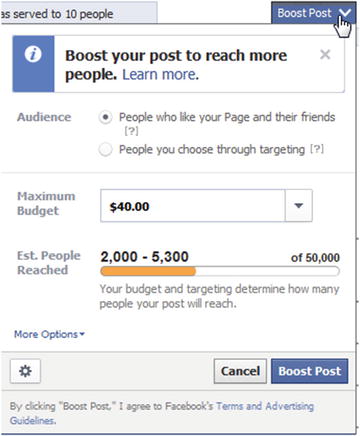
Granted, in this “boost” scheme , Facebook is including a way to reach more people beyond your audience. But it is also charging you to reach people who liked your page. So if you thought reaching your fans was free, think again.
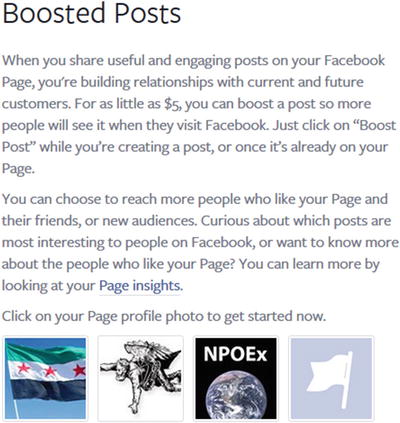
From my perspective, I think it ends up being a little like Google ads. There’s competition , and to a certain extent, it’s like Facebook is treating people’s newsfeeds like Google search results. You can pay Facebook to get a better change of being noticed.
In the end, it’s helpful to keep in mind the way things work, decide what your goal is, and then look at the results to see if it’s worth it. There’s no rule either way; it’s worth experimenting. Some businesses have had success gaining followers and leveraging Facebook pages to help establish and maintain their presence on social media. From a credibility perspective, many argue that part of maintaining “social credibility” is having a social media page.
But there are also instances where the effort and money put into a Facebook page leads to questionable results.
For example, here’s an article where someone looked with a critical eye, did some testing, and found out that Facebook pages, for them, weren’t such a good idea:
“Facebook Pages Are a Bad Idea” http://www.forbes.com/sites/elandekel/2013/01/22/facebook-pages-are-a-bad-investment-for-small-businesses/
In the end, I think Facebook pages are definitely worth learning about. They are legitimate hubs for social media. I recommend thinking of Facebook as an experiment. Try it out and see how it works, then look at the numbers.
In terms of content, if you are creating content about your organization and giving it a home on your web site or blog, the most important thing is that you are building up an archive of stories about your organization. Even if you never posted them on social media, they would be important. (In part, because they help a web site get recognition on Google. In other words, even though SEO has its limitations, just putting content on your site draws people there and helps you with Google search results.)
If you already have the content, why not share it on social media? Just remember to “drill down” and look at how many people are actually seeing it—to set realistic expectations.
Part of your social media strategy might involve trying different ways of increasing engagement, such as creating a video that has more of a chance of being shared because of its appeal—the story, the humor, the relevance of information. The same idea applies to articles.
The bottom line is—social media is worth trying.
Creating a Facebook Page
Creating a Facebook page is fairly easy. Just go to https://www.facebook.com/pages/create to get started.
There are a variety of page types, and I recommend clicking on various ones to try them.
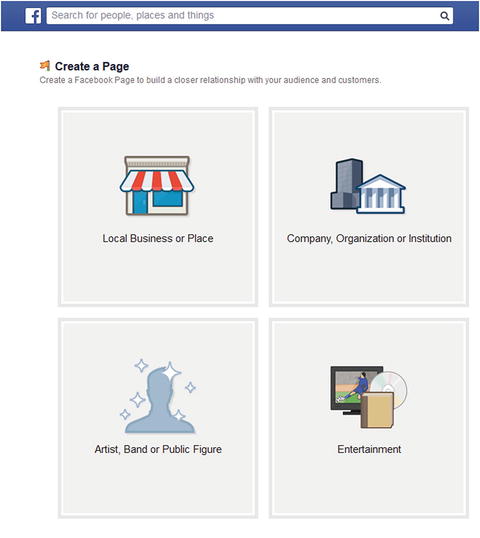
For example, you might try clicking on the Company type :

Then you choose a category :
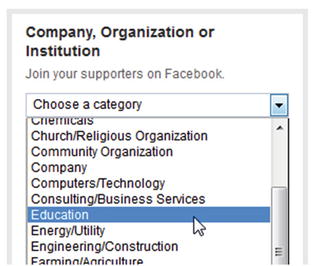
Type in a name for the business and then click Get Started :
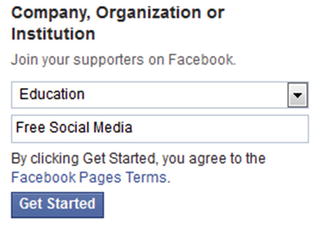
Next you will be led through a series of screens where you can enter basic information .
As a learning exercise, I recommend making a checklist that you can refer to later, in order to assemble this content. But for now, I suggest clicking the Skip button on each page:
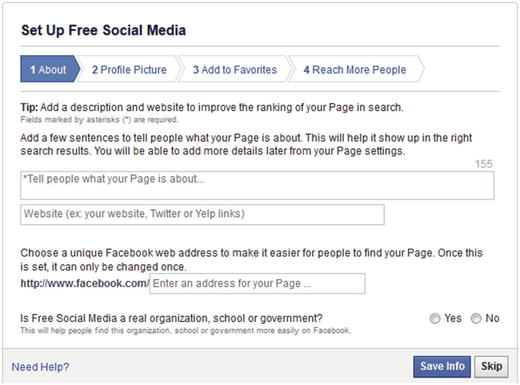
The second screen allows you to upload a picture . (Nudge nudge—see Chapter 2.)
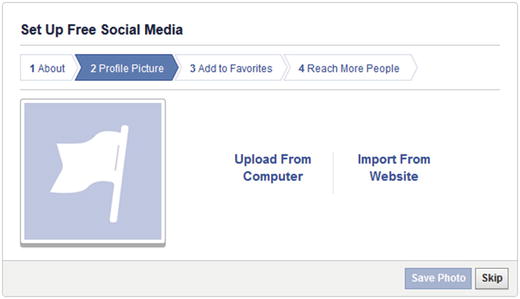
This is probably worth doing—it just makes your page easier to find and manage when you sign in to Facebook . Favorites refers to your “Favorites” area on the home page when you sign in to Facebook, until/unless Facebook changes its format:
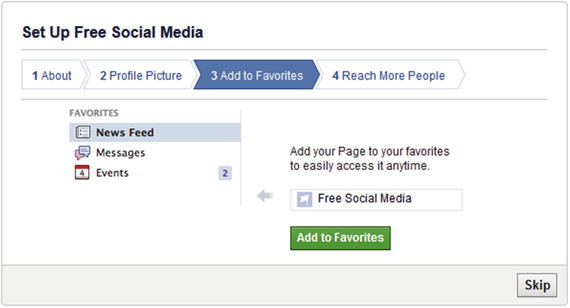
Then you get an introduction to Facebook advertising , ending with inviting you to create an ad. How does Facebook make money? Through ads.
As you’ll see in Chapter 4, there’s a variety of ways to create an ad. I recommend skipping this page for now.

And then, voila! You have your draft Facebook page :

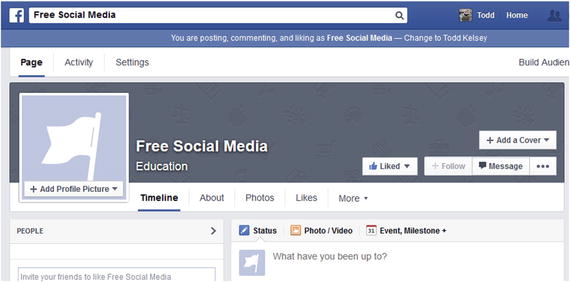
Congratulations on making a Facebook page .
Remember, you can always access Facebook Help for more information: https://www.facebook.com/help/364458366957655/
This page has good, basic information about creating and managing a Facebook page, which is worth reviewing.
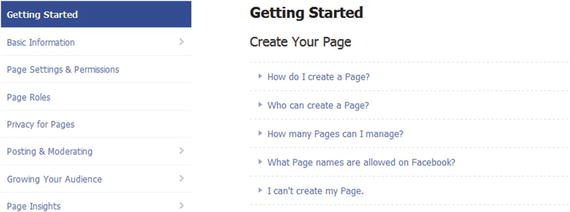
Posting to the Page
The general point of having a Facebook page is to get people to like it by promoting it and to make posts to it.
One point to keep in mind is that Facebook allows you to post as “yourself” to a Facebook page, but it also allows you to make posts “as” the page.
For example, on the facebook.com/npoex page, I can post to it as Todd Kelsey. In general, it’s better to post as the page, so that the posts are marked as coming from NPOEx.
Just something to keep in mind.
Content! Content!
Here’s another opportunity to revisit and reconsider the chapter and skills about content . Here’s where you are asking yourself, “Okay, what can I post?”
And here’s where, if you haven’t already, you may want to make a blog or post and then post that link (about your organization, or thoughts, or whatever) on Facebook.
To post, you just click in the post area. (For example, you can use the “What have you been up to?” area.)

You could type something, like Hello world!:

Then you click the Post button .
You get a post like the following one:
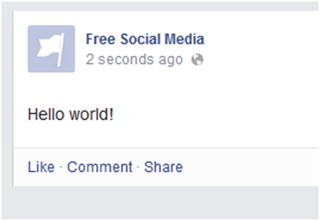
Accessing Pages
You can access your Facebook pages by going directly to them, or by logging in to Facebook, clicking on Home, and then looking for the page on the left side:
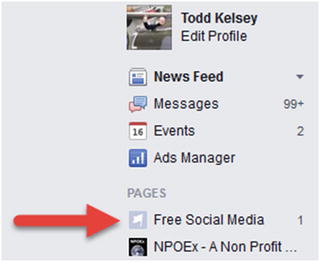
Facebook Page Links
If I access my page using the previous method above, I get a link like this one in the browser’s address bar: https://www.facebook.com/pages/Free-Social-Media/1510620519168937?ref_type=bookmark
This link can be shortened to https://www.facebook.com/pages/Free-Social-Media/1510620519168937 .
(You don’t need the information beginning with the question mark.)
This is the basic link to the Facebook page. People can also search on Facebook for the page based on the name you choose:

Facebook Page Usernames
In general, at some point, you’ll probably want a shorter link so your page is easier to find and promote.
Instead of a long link like https://www.facebook.com/pages/Free-Social-Media/1510620519168937?ref_type=bookmark , you’ll want a shorter link, which is easier to promote, such as www.facebook.com/npoex .
In order to create a shorter link, you have to create a Facebook page username.
To get one, go to your Facebook page and click on Settings:

Then go to Page info:
Click on Enter a Facebook Web Address:

Then, click on Create a Web Address for This Page?. You can click on the question mark (?) to get more info if you need to:

This helps you create a web address name that hasn’t been taken on Facebook :

Click on the Facebook Web Address field, type a name, and then click on Check Availability. When you find one that’s available, review the info and click Confirm:

Then click OK:

Then you will have a shorter link, such as https://www.facebook.com/FreeSocialMediaInfo .
Some businesses advertise by removing the http and www, such as facebook.com/FreeSocialMediaInfo.
The More Things Change…
Another point I think is helpful to keep in mind is that Facebook and other social media channels regularly change their features, often out of a desire to improve or be more secure. So the way that Facebook pages work may change (for example, there weren’t originally cover images), the interface used to work with them might change, or additional features will be added.
My general suggestion is to explore Facebook and review the help. Facebook often sends e-mails with updates as well. Learn how to learn and don’t be afraid to experiment as new features come out.
Learning More
Facebook’s help section provides more good information at https://www.facebook.com/help/364458366957655/ .
Conclusion
Best wishes in exploring Facebook pages! My general recommendation is to focus on the content, and not the channel, such as Facebook. Once you are developing content, experiment with posting it to various social media channels. Use Google to search for articles that discuss social media strategy, including what to post, how often to post, etc. A safe rule is to consider what your audience would be interested in reading.
Remember to always see how many people you are actually reaching with your posts!
